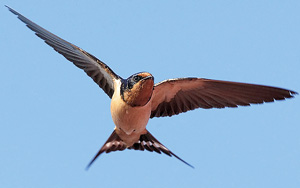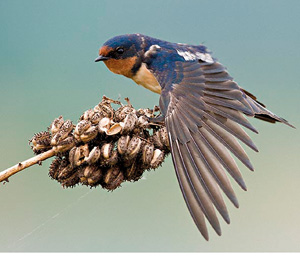Meet Atu – the acrobatic Barn Swallow!
View(s):
Barn Swallow in flight (c) Jerry Ting
The bird migration season has started and Bighu – the Bee-eater has already arrived. This week, we welcome Atu – the Barn Swallow. It was Sunday morning and Uncle Bird, the Birdwatcher came to the garden with his binoculars to greet the birds. There was a new visitor; Atu – the Barn Swallow doing his morning exercises flying up and down at high speed.
“Good Morning Atu. How are you?”
“Not bad. I came with a group of friends,” said Atu, showing the other Barn Swallows, who were busy catching insects for breakfast.
“Bighu; the migrant Bee-eater is already here. Have you met him?” asked Uncle Bird while trying to locate the fast moving Atu through the bino.
“Yes, I met him on the way. It is indeed nice to be back in Sri Lanka again,” Atu said.
“By the way, have you seen Auntie Avichchie?” Uncle Bird asked. “Last year she was complaining of body aches after the long flight.”
Perched on an electric wire, Atu was doing some stretching exercises after the long flight. “She’s alright and will arrive late next month. We don’t have such problems like Auntie Avichchie. Our body is streamlined for flight, so we can fly efficiently. Everyone should exercise regularly and keep fit like me,” Atu said doing some acrobatic movements in the sky with another friend.

A stretching Barn Swallow (c) Greg Lasley
“Small birds like us prefer to take off and do our annual migration flight during the night. But our
larger colleagues prefer day time,” Atu explained. “The larger cousins like cranes and storks have heavier
bodies, so they try to glide as much as possible using the earth’s thermal upwinds”, said Atu, further
explaining some secrets of bird migration.
“Yes, when the sun is up, the land gets warm and heated air goes up. So these birds can make use of the heated air to glide, which makes the journey easier for them,” Uncle Bird added.
“By the way, why do you always roost together at night?” asked Uncle Bird recalling thousands of Barn Swallows perched on electric wires in Ratnapura Town.
“Well, we like to stay together. It keeps us warm and also because there are so many eyes to look around, we also get security from our enemies,” Atu explained. “Many other birds also do the same” he said.
Barn Swallow ( Atu wehi lihiniya)
The Barn Swallow is a small bird that is about 70cm in length from the tip of beak to the end of the tail. It is a slender and active bird.
Barn swallows can be found in many areas throughout the world. They have dark metallic blue upperparts and bright reddish brown forehead and throat. The tail is deeply forked helping them to manoeuvre easily in flight.
Like other swallows, they are insectivores and catch insects on the wing. Barn Swallows like open areas more than forests and can be found in cities like Colombo. They roost together at night and electric wires become their favourite night roosts for the populations that settle in towns. The Barn Swallows that roost in their thousands in Ratnapura are a spectacular sight witnessed by many. But they must be roosting together in other places too, so when you go out be vigilant and observe them.
Barn Swallow is also the National Bird of Austria and Estonia.
Scientific Name: Hirundo rustica


